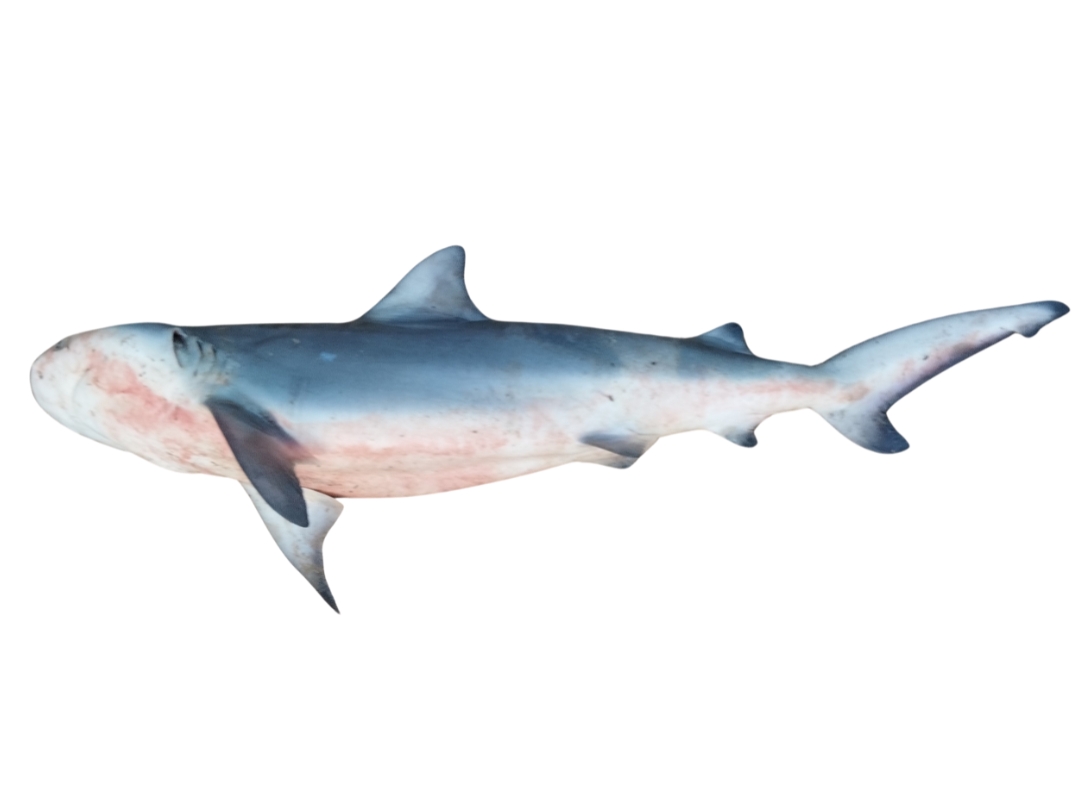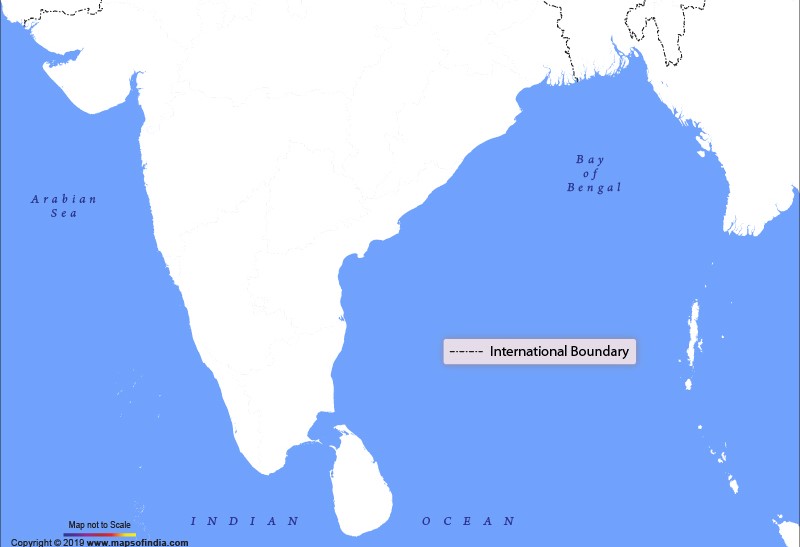Species Name
Bull Shark
Scientific Name
Carcharhinus leucas (valenciennes in müller & henle, 1839)
Family Name
Carcharhinidae
IUCN Status
Vulnerable
The Bull shark is a massive elasmobranch with a short, broad and blunt snout, small eyes and triangular saw-edged upper teeth, and lack of interdorsal ridge, characters which are sufficient to distinguish this species.
Biology
Length: It reaches a maximum size of 400 cm total length (TL), but is mostly reported to be 340–366 cm total maximum length. Males mature at 157–226 cm TL and females mature at 180–230 cm TL.
Gestation Period: 10-11 months
Litter Size: upto 13 (usually 6-8)
Life Expectancy: Age estimates vary regionally. In Australia and South Africa, female age-at-maturity is 9.5 and 21 years and maximum age is 27 and 32 years, respectively; thus, generation length is 18.2 and 26.5 years, respectively. In the Northwest Atlantic and Gulf of Mexico, female age-at-maturity is 15 and 10–18 years and maximum age is 27 and 24–28 years, respectively; thus, generation length is 21 and 19–21 years, respectively.
Diet: Feeds on bony fishes, other sharks, rays, mantis shrimps, crabs, squid, sea snails, sea urchins, mammalian carrion, sea turtles, and occasionally garbage .
Habitat and distribution
Habitat: A coastal and freshwater shark inhabiting shallow waters especially in bays, estuaries, rivers, and lakes. It readily penetrates far up rivers and hypersaline bays and littoral lagoons. Capable of covering great distances (up to 180 kilometers in 24 hours), moving between fresh and brackish water at random. Adults often found near estuaries and freshwater inflows to the sea; young enter rivers and may be found hundreds of km from the sea.
Distribution: The Bull Shark has a circumglobal distribution. The species travels large distances up rivers and remains in freshwater for extended periods of time. It has currently been documented from 125 freshwater rivers and lakes across all continents in its range and likely occurs in any river within its range of suitable depth, temperature, current, and available prey.
Depth: 0-164 m
Known landing centres: Sassoon Docks, New Ferry Wharf, Royapuram Fishing Harbour, Cuddalore Fishing Harbour, Nagapattinam Fishing Harbour, Junglighat, Burmanallah, Wandoor, Dignabad, Kakinada, Cochin Fisheries Harbour, Veraval, Mangrol, Porbander, Okha
Commercial value
The Bull Shark is used for its meat which is consumed fresh locally and dried and exported and for its fins. The skin and liver oil are also used commercially, and in Pakistan, the late-term embryos are among the highest valued fish.
Threats
The Bull Shark is subject to fishing pressure across its range. It is caught as target and bycatch in artisanal, industrial, and recreational fisheries across its range with multiple fishing gears including gillnet, longline, and trawl. It is mostly retained for its meat and fins. This species preference for inshore coastal waters, estuarine, and riverine habitats means it is also threatened by habitat loss and degradation, including pollution and clearing, and climate change. Global climate change has already resulted in large-scale coral bleaching events with increasing frequency causing worldwide reef degradation since 1997.
References
Akhilesh, K.V., Ganga, U., Pillai, N.G.K., Vivekanandan, E., Bineesh, K.K., Shanis, C.P.R. and Hashim, M. (2011)
Deep-sea fishing for chondrichthyan resources and sustainability concerns— a case study from southwest coast of India. Indian Journal of Geo-Marine Sciences 40(3): 347-355.
Anticamara, J.A., Watson, R., Gelchu, A. and Pauly, D. (2011)
Global fishing effort (1950–2010): Trends, gaps, and implications. Fisheries Research 107(2011): 131-136.
Arai, T. and Azri, A. (2019)
Diversity, occurrence and conservation of sharks in the southern South China Sea. PLoS ONE 14(3): e0213864.
Arunrugstichai, S., True, J.D. and White, W.T. (2018)
Catch composition and aspects of the biology of sharks caught by Thai commercial fisheries in the Andaman Sea. Journal of Fish Biology 92: 1487–1504.
Branstetter, S. and Stiles, R. (1987)
Age and growth of the bull shark, Carcharhinus leucas, from the northern Gulf of Mexico. Environmental Biology of Fishes 20: 169–181.
Cardeñosa, D., Fields, A.T., Babcock, E.A., Shea, S.K.H., Feldheim, K.A., and Chapman, D.D. (2020)
Species composition of the largest shark fin retail-market in mainland China. Scientific Reports 10(1): 12914.
Cardno (2019)
Queensland Shark Control Program. Review of Alternative Approaches. Cardno (NSW/ACT) Pty Ltd.
Carlson, J.K., Hale, L.F., Morgan, A. and Burgess, G. (2012)
Relative abundance and size of coastal sharks derived from commercial shark longline catch and effort data. Journal of Fish Biology 80: 1749-1764.
Castro, J.I. (1983)
The Sharks of North American Waters. Texas A. and M. University Press, College Station, USA.
Compagno, L.J.V. (1984)
FAO Species Catalogue. Vol. 4. Sharks of the world. An annotated and illustrated catalogue of shark species known to date. Part 2 - Carcharhiniformes. FAO Fish. Synop. 125(4/2):251-655. Rome: FAO.
Chong, K.C., Dwiponggo, A., Ilyas, S. and Martosubroto, P. (1987)
Some experiences and highlights of the Indonesian trawl ban: Bioeconomics and socio-economics. Indo-Pacific Fisheries Commission RAPA report. (10):458–477.
Cruz-Martínez, A., Chiappa-Carrara, X. and Arenus-Fuentes, V. (2005)
Age and Growth of the Bull Shark, Carcharhinus leucas, from Southern Gulf of Mexico. Journal of Northwest Atlantic Fishery Science 35: 367–374.
Curtis T.H., Adams, D.H. and Burgess, G.H. (2011)
Seasonal distribution and habitat associations of Bull Sharks in the Indian River Lagoon, Florida: A 30-Year synthesis. Transactions of the American Fisheries Society 140(5): 1213–1226.
Daly, R., Smale, M.J., Cowley, D. and Froneman, P.W. (2014)
Residency patterns and migration dynamics of adult bull sharks (Carcharhinus leucas) on the east coast of southern Africa. PLOS ONE 9(10): e109357.
Deng, Z., Chen, J., Song, N., Li, Y. and Han, Z. (2019)
Genetic homogeneity among Bull Sharks Carcharhinus leucas in the South China Sea. Pakistan Journal of Zoology 51(4): 1281–1288.
Dudley, S. and Simpfendorfer, C. (2006)
Population status of 14 shark species caught in the protective gillnets off KwaZulu-Natal beaches, South Africa, 1978-2003. Marine and Freshwater Research 57: 225-240.
Ebert, D.A., Fowler, S. and Compagno, L. (2013)
Sharks of the World. A Fully Illustrated Guide. Wild Nature Press, Plymouth, United Kingdom.
Espinoza, M., Heupel, M.R., Tobin, A.J. and Simpfendorfer, C.A. (2016)
Evidence of partial migration in a large coastal predator: opportunistic foraging and reproduction as key drivers? PLOS ONE 11(2): e0147608.
Fernando, D. (2014)
Range Extension of the Bull Shark Carcharhinus leucas (Carcharhiniformes: Carcharhinidae) to include Sri Lanka. Loris - Journal of the Wildlife and Nature Protection Society of Sri Lanka 27: 26–27.
Fields, A.T., Fischer, G.A., Shea, S.K., Zhang, H., Abercrombie, D.L., Feldheim, K.A., Babcock, E.A. and Chapman, D.D. (2018)
Species composition of the international shark fin trade assessed through a retail‐market survey in Hong Kong. Conservation Biology 32(2): 376–389.
Froeschke, J.T., Froeschke, B.F., Stinson, C.M. and Hilborn, R. (2012) Long-term trends of bull shark (Carcharhinus leucas) in estuarine waters of Texas, USA. Canadian Journal of Fisheries and Aquatic Sciences 70(1): 13–21.
Gausmann, P. (2018)
Synopsis of global freshwater occurrences of the bull shark (Carcharhinus leucas Valenciennes 1839, Carcharhinidae) with comments on the geographical range. Unpublished report.
Guyomard, D., Lee, K.A., Perry, C., Jaquemet, S. and Cliff, G. (2020) SMART drumlines at Réunion Island do not attract bull sharks Carcharhinus leucas into nearshore waters: Evidence from acoustic monitoring. Fisheries Research 225: 105480.
Harry, A.V.,Tobin, A. J., Simpfendorfer, C.A., Welch, D.J., Mapleston A., White, J.W., Ashley J. and Stapley, J. (2011)
Evaluating catch and mitigating risk in a multispecies, tropical, inshore shark fishery within the Great Barrier Reef World Heritage Area. Marine and Freshwater Research 62(6): 710–721.
Henderson, A.C. and Reeve, A.J. (2014)
Assessment of Shark Population Movements, Delineations and Breeding Grounds in the Sultanate of Oman. Final Report. Sultan Qaboos University, Muscat.
Henderson, A.C., McIlwain, J.L., Al-Oufi, H.S. and Al-Sheili, S. (2007)
The Sultanate of Oman shark fishery: Species composition, seasonality and diversity. Fisheries Research 86: 159-168.
Heupel, M.R. and Simpfendorfer. C.A. (2008)
Movement and distribution of young bull sharks Carcharhinus leucas in a variable estuarine environment. Aquatic Biology 1: 277–289.
Heupel, M.R. Simpfendorfer, C.A., Espinoza, M. Smoothy, A.F., Tobin, A.J. and Peddemors, V.M. (2015)
Conservation challenges of sharks with continental scale migrations. Frontiers in Marine Science 2(12): doi: 10.3389/fmars.2015.00012.
IPCC (2019)
IPCC Special Report on the Ocean and Cryosphere in a Changing Climate. In: Pörtner, H.-O., Roberts, D.C., Masson-Delmotte, V., Zhai, P., Tignor, M., Poloczanska, E., Mintenbeck, K., Alegría, A., Nicolai, M., Okem, A., Petzold, J., Rama, B. and Weyer N.M. (eds). Intergovernmental Panel on Climate Change, Geneva, Switzerland.
Iqbal, M., Nurnawati, E., Setiawan, A., Dahlan, Z. and Yustian, I. (2019)
First photographic inland records of bull shark Carcharhinus leucas (Carcharhiniformes: Carcharhinidae) in Sumatran waters, Indonesia. Ecologica Montenegrina 22: 171–176.
IUCN (2021)
The IUCN Red List of Threatened Species. Version 2021-2. Available at: www.iucnredlist.org. (Accessed: 04 September 2021).
Jabado, R.W., Al Ghais, S.M., Hamza, W., Henderson, A.C., Spaet, J.L.Y., Shivji, M.S. and Hanner, R.H. (2015)
The trade in sharks and their products in the United Arab Emirates. Biological Conservation 181: 190-198.
Jabado, R.W., Al Ghais, S.M., Hamza, W., Robinson, D.P. and Henderson, A.C. (2016)
Biological data from sharks landed within the United Arab Emirates artisanal fishery. African Journal of Marine Science 38(2): 217-232.
Kizhakudan, S.J., Zacharia, P.U., Thomas, S, Vivekanandan, E, and Muktha, M. (2015)
Guidance on National Plan of Action for Sharks in India. . CMFRI Marine Fisheries Policy Series .
McCord, M.E. and Lamberth, S.J. (2009)
Catching and tracking the world’s largest Zambezi (bull) shark Carcarhinus leucas in the Breede Estuary, South Africa: the first 43 hours. African Journal of Marine Science 31: 107–111.
Moore, A.B.M. and Peirce, R. (2013)
Composition of elasmobranch landings in Bahrain. African Journal of Marine Science 35: 593-596.
Moore, A.B.M., Ward, R.D. and Peirce, R. (2012)
Sharks of the Persian (Arabian) Gulf: a first annotated checklist (Chondrichthyes: Elasmobranchii). Zootaxa 3167: 1–16.
Natanson, L.J., Adams, D.H., Winton, M. V. and Maurer, J.R. (2014)
Age and growth of the Bull Shark in the Western North Atlantic Ocean. Transactions of the American Fisheries Society 143: 732–743.
Nevill, J.E.G., Bamboche,D. and Philoe, H. (2014)
Record litter size for the bull shark, Carcharhinus leucas (Muller & Henle, 1839), documented in the Seychelles. Western Indian Ocean Journal of Marine Science 12: 85.
Pattillo, M., Czapla, T.E., Nelson, D.M. and Monaco, M.E. (1997) Distribution and abundance of fisheries and invertebrates in Gulf of Mexico Estuaries, Volume II: Species life history summaries. NOAA/NOSStrategic Environmental Assessments Division. ELMR Report 11.
Pauly, D., Zeller, D. and Palomares, M.L.D. (2020)
Sea Around Us Concepts, Design and Data. Available at: seaaroundus.org. (Accessed: April 2020).
Pillans, R.D. and Franklin, C.E. (2004)
Plasma osmolyte concentrations and rectal gland mass of bull sharks Carcharhinus leucas, captured along a salinity gradient. Journal of Comparative Physiology Part A 138: 363–371.
Pirog, A., Ravigné, V., Fontaine, M.C., Rieux, A., Gilabert, A., Cliff, G., Clua, E., Daly, R., Heithaus, M.R., Kiszka, J.J., Matich, P., Nevill, J.E.G., Smoothey, A.F., Temple, A.J., Berggren, P., Jaquemet, S. and Magalon, H. (2019)
Population structure, connectivity, and demographic history of an apex marine predator, the bull shark Carcharhinus leucas. Ecology and Evolution 9(23): 12980–13000.
Psomadakis, P.N., Htun Thein, Russell, B.C. and Mya Than Tun (2019) Field identification guide to the living marine resources of Myanmar. FAO Species Identification Guide for Fishery Purposes. FAO and MOALI, Rome.
Reid, D.D., Robbins, W.D. and Peddemors, V.M. (2011)
Decadal trends in shark catches and effort from the New South Wales, Australia, Shark Meshing Program 1950-2010. Marine and Freshwater Research 62: 676-693.
Rodríguez-Arriati, Y. N. (2011)
Impacto de la pesquería artesanal en la disminución de las poblaciones de tiburones en el pacifico oriental de Panamá. Proyecto “Plan piloto de Monitoreo de los Desembarques de Tiburones y Rayas en el Pacífico Oriental Panameño. Autoridad de los Recursos Acuáticos de Panamá.
Roff, G., Brown, C.J., Priest, M.A. and Mumby, P.J. (2018)
Decline of coastal apex shark populations over the past half century. Communications Biology 1(1): 223.
Sandoval Laurrabaquio-A, N., Islas-Villanueva, V., Adams, D.H., Uribe-Alcocer, M., Alvarado-Bremer, J.R. and Díaz-Jaimes, P. (2019)
Genetic evidence for regional philopatry of the Bull Shark (Carcharhinus leucas), to nursery areas in estuaries of the Gulf of Mexico and western North Atlantic ocean. Fisheries Research 209: 67–74.
SEAFDEC. 2016. Report on Regional Sharks Data Collection 2015 to (2016)
Results from data collection 2015 to 2016: Results from data collection in sharks project participating countries. SEAFDEC Secretariat. Southeast Asian Fisheries Development Center.
Sherley, R.B., Winker, H., Rigby, C.L., Kyne, P.M., Pollom, R., Pacoureau, N., Herman, K., Carlson, J.K., Yin, J.S., Kindsvater, H.K. and Dulvy, N.K. (2020)
Estimating IUCN Red List population reduction: JARA—A decision-support tool applied to pelagic sharks. Conservation Letters 13(2): e12688.
Simpfendorfer, C.A., de Jong, S.K. and Sumpton, W. (2010)
Long-term trends in large shark populations from inshore areas of the Great Barrier Reef World Heritage Area: results from the Queensland Shark Control Program. Marine and Tropical Sciences Research Facility Transition Program Report.
Soria, M., Heithaus, M.R., Blaison, A., Crochelet, E., Forget, F. and Chabanet, P. (2019)
Residency and spatial distribution of bull sharks Carcharhinus leucas in and around Reunion Island marine protected area. Marine Ecology Progress Series 630(101–113).
Thomerson, J.E. and Thorson, T.B. (1977)
The bull shark, Carcharhinus leucas, from the Mississippi River near Alton, Illinois. Copeia 1(166–168).
Tillett, B.J., Meekan, M.G., Field, I.C., Hua, Q. and Bradshaw, C.J.A. (2011)
Similar life history traits in bull (Carcharhinus leucas) and pig-eye (C. amboinensis) sharks. Marine and Freshwater Research 62(7): 850-860.
Tillett B.J., Meekan, M.G., Field, I.C.,Thorburn, D.C. and Ovenden, J.R. (2012)
Evidence for reproductive philopatry in the bull shark Carcharhinus leucas. Journal of Fish Biology 80(6): 2140–2158.
Watson, R.A., Cheung, W.W.L., Anticamara, J.A., Sumaila, R.U., Zeller, D. and Pauly, D. (2013)
Global marine yield halved as fishing intensity redoubles. Fish and Fisheries 14(4): 493–503.
Weigmann, S. (2016)
Annotated checklist of the living sharks, batoids and chimaeras (Chondrichthyes) of the world, with a focus on biogeographical diversity. Journal of Fish Biology 88(3): 837-1037.
Werry, J.M. (2010)
Habitat ecology of the bull shark, Carcharhinus leucas, on urban coasts in eastern Queensland, Australia. Griffith University Gold Coast.
Werry, J.M., Lee, S.Y., Lemckert, C.J. and Otway, N.M. (2012)
Natural or Artificial? Habitat-Use by the Bull Shark, Carcharhinus leucas. PLOS ONE 7(11): e49796.
Winker, H, Pacoureau, N. and Sherley, R.B. (2020)
JARA: 'Just Another Red List Assessment'. BioR𝝌iv Preprint: http://dx.doi.org/10.1101/672899.
Wintner, S. P., Dudley, S. F. J., Kistnasamy, N., and Everett, B. (2002)
Age and growth estimates for the Zambezi shark, Carcharhinus leucas, from the east coast of South Africa. Marine and Freshwater Research 53(2): 557–566.


Related Species
- Tiger Shark
- Silky Shark
- Blacktip Reef Shark
- Common Blacktip Shark
- Spot-tail Shark
- Milk Shark
- Spadenose Shark
- Bignose Shark
- Blackspot Shark
- Blue Shark
- Broadfin Shark
- Dusky Shark
- Ganges Shark
- Graceful Shark
- Grey Reef Shark
- Grey Sharpnose Shark
- Hardnose Shark
- Sliteye Shark
- Silvertip Shark
- Sharptooth Lemon Shark
- Sandbar Shark
- Pondicherry Shark
- Pigeye Shark
- Oceanic Whitetip Shark
- Irrawaddy River Shark
- Speartooth Shark
- Spinner Shark
- Whitecheek Shark
- Whitetip Reef Shark

